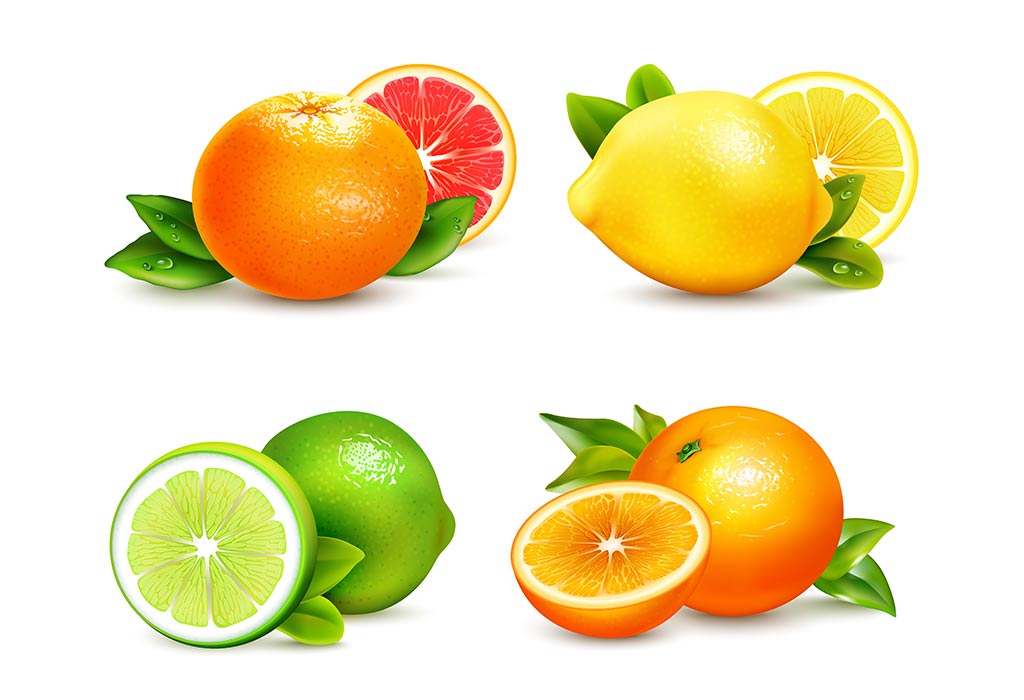Fruits are all around us and make for an important part of a healthy diet because they are rich in vitamins, minerals, and fibre. They can be classified according to the part of the plant that they come from, such as the seeds (legumes), the flowers (fruit), or the vegetative structures (vegetables).
Fruits are also classified according to their botanical characteristics, such as whether they have a single seed or multiple seeds, and whether they are fleshy or dry. Some common types of fruits include apples, bananas, berries, citrus fruits, and melons. Fruits can be eaten fresh, frozen, canned, or dried, and can also be used to make juices, jams, and other products.
In this piece, we will look at the meaning of citrus fruits, how they benefit us and learn their names. Let’s begin!
What Are Citrus Fruits?
Citrus fruits or the meaning of citrus fruits is that they are a type of fruit that are high in vitamin C and other nutrients. They are a good choice for kids as they are generally well-liked and can be an enjoyable and healthy snack. Some examples of the best citrus fruits include:
- Oranges: Oranges are a classic citrus fruit that are high in vitamin C and fibre. They are relatively easy to peel and can be eaten as a snack or used in recipes such as salads and smoothies.
- Grapefruits: Grapefruits are slightly tart citrus fruits that are high in vitamin C and vitamin A. They can be eaten as a snack or used in recipes such as salads and juices.
- Lemons: Lemons are tart citrus fruits that are high in vitamin C and potassium. They can be used in many different types of recipes, such as dressings, sauces, and drinks, or can be squeezed over foods for added flavour.
- Limes: Limes are a tart citrus fruit that are high in vitamin C and calcium. They can be used in many recipes, such as dressings, sauces, and drinks, or can be squeezed over foods for added flavour.
- Tangerines: Tangerines, also known as mandarins, are a small, sweet citrus fruit that are high in vitamin C and potassium. They are easy to peel and are a good snack for kids.
It is important to encourage kids to eat a variety of fruits, including citrus fruits, as part of a healthy and balanced diet. Let us now look at the benefits of citrus fruits below.
What Are The Health Benefits Of Citrus Fruits?
There’s a huge variety of citrus fruits, such as oranges, lemons, and grapefruits, and these are a good source of vitamin C and other important nutrients. They have several potential health benefits, including:
1. Boosting the immune system
Vitamin C is important for maintaining a healthy immune system, and citrus fruits are a good source of this nutrient.
2. Reducing the risk of heart disease
Some studies have found that consuming citrus fruits may help lower the risk of heart disease by reducing high blood pressure and cholesterol levels.
3. Promoting healthy skin
Vitamin C is important for the production of collagen, which helps keep skin looking youthful and healthy.
4. Supporting weight loss
Citrus fruits are low in calories and high in fibre, making them a good choice for people trying to lose weight.
5. Reducing the risk of certain cancers
Some studies have suggested that consuming citrus fruits may help reduce the risk of certain types of cancer, such as breast and stomach cancer.
6. Improving digestion
The fibre in citrus fruits can help promote regular bowel movements and improve digestion.
7. Reducing inflammation
Some studies have found that the compounds in citrus fruits may have anti-inflammatory effects, which may help reduce the risk of certain chronic diseases.
List Of Common Citrus Fruits
Let’s now take a look at a list of all the citrus fruits that we eat in our daily lives below.
1. Oranges
Oranges are round, sweet fruits that are a good source of vitamin C. They have a bright orange peel and are typically eaten fresh or used to make juice.
2. Lemons
Lemons are oval-shaped fruits with a sour, acidic taste. They are often used to add flavour to food and drink and are a good source of vitamin C.
3. Grapefruits
Grapefruits are round or oval-shaped fruits that are similar in size to oranges. They have a slightly bitter, tart taste and are a good source of vitamin C.
4. Tangerines
Tangerines, also known as mandarins, are small, sweet oranges that are easy to peel. They’re a great source of vitamin C and other nutrients.
5. Clementines
Clementines are small, sweet oranges that are similar to tangerines. They are a strong source of vitamin C and other nutrients.
6. Limes
Limes are small, green citrus fruits with a sour, acidic taste. They are often used to add flavour to food and drinks and are a good source of vitamin C.
7. Pomelos
Pomelos are large, round citrus fruits that have a sweet, grapefruit-like flavour. They are a good source of vitamin C and other nutrients.
8. Kumquats
Kumquats are small, oval-shaped citrus fruits with a sweet peel and sour flesh. They are often eaten fresh or used to make preserves.
9. Bergamots
Bergamots are small, round citrus fruits with yellow-green skin and a sour, acidic taste. They are often used to make essential oils and perfumes.
10. Calamondins
Calamondins are small, round citrus fruits that are similar in size and shape to limes. They have a sour, acidic taste and are often used in cooking and as a garnish.
Other Types Of Citrus Fruits
In this section, we will look at examples of citrus fruits for preschoolers:
- Kabosu
- Sudachi
- Persian lime
- Finger Lime
- Yuzu
- Kiyomi
- Shonan Gold
- Daidai
- Micrantha
- Orangelo
- Hassaku orange
- Mangshanyegan
- Blood orange
- Buddha’s hand
- Kaffir lime
- Lumia
- Cara cara navel
Fun Facts About Citrus Fruits
As an added bonus, we wanted to share some fun facts about citrus fruits! Take a look at them below :
- The word “citrus” comes from the Latin word “citrus,” which means “lemon.”
- Surprisingly, Oranges (and not lemons!) are the most popular citrus fruit in the world.
- Citrus fruits are native to Southeast Asia and were introduced to the Mediterranean region by Arab traders.
- Citrus fruits are high in acidity, which makes them difficult for certain pests to eat.
- Citrus fruits are often used to add flavour to food and drink, and they are also used to make essential oils and perfumes.
- Citrus fruits are a good source of vitamin C, which helps boost the immune system and promote healthy skin.
- The peels of citrus fruits can be used to make marmalade, candied peel, and other products.
- Citrus fruits are often used in traditional medicine to treat a variety of ailments – more often than not, colds and flu.
- Citrus fruits are high in antioxidants, which may help protect against certain diseases.
So the next time you are at a fruit market, or enjoying a big bowl of citrus fruits topped with whipped cream and chocolate sauce, ask your child if they can name them all! Afterall, learning from interesting resources combined with observing real life is the most effective way to remember facts.
Also Read:
Names of Fruits for Kids
Vegetable Names in English for Children
Root Vegetables Names for Kids










